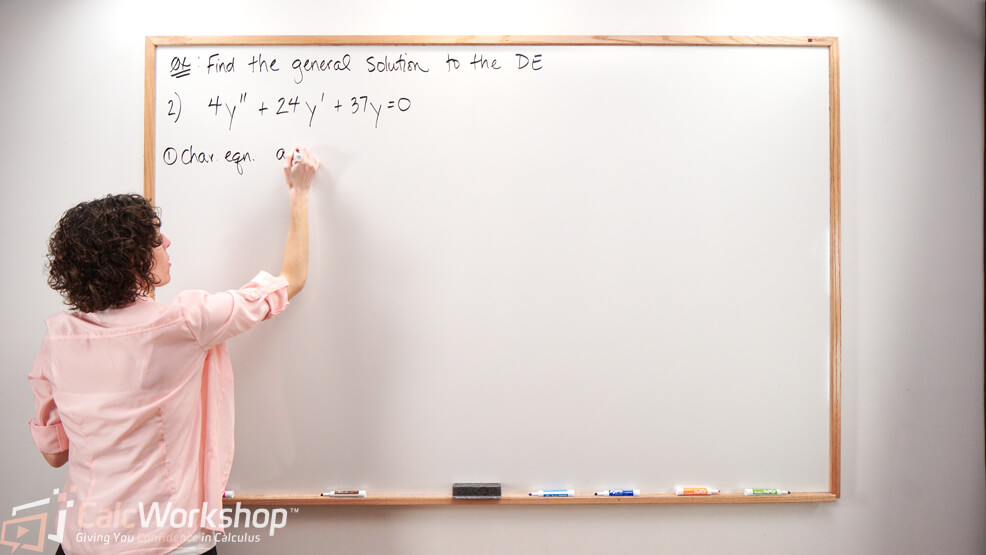Complex roots are no match for a systematic approach to solving second-order differential equations and higher-order DEs.

Jenn, Founder Calcworkshop®, 15+ Years Experience (Licensed & Certified Teacher)
While these roots may appear challenging at first, with the right method and understanding, you’ll find that the process and solutions is fairly straight forward.
I promise!
So, let’s quickly review what we learned in our previous lesson involving the characteristic equation and real and distinct roots.
When solving a homogeneous linear higher order differential equation of the form
we first create a characteristic equation, using the principle of supperposition, for which we will then solve for roots.
Our focus with this lesson is to learn how to find the general and particular solution to a second order homogeneouls linear differential equation that has imaginary or complex roots.
Steps for Solving Homogeneous Linear Differential Equations with Constant Coefficients
First, let’s look over the steps for solving and creating the general solution to a second order or higher order homogeneous differential equations with constant coefficients.
- Write the characteristic equation
- Solve the polynomial equation for factors by using factoring or quadratic formula.
- Substitute each root into the general form
Distinct Real Roots:
Complex Roots:
Example: Finding the General Solution with Complex Roots
Okay, so let’s look at an example to help us make sense of our method.
Find the general solution of
First, we will transform our DE into the characteristic equation
Next, we will solve the quadratic polynomial for our roots using the quadratic formula
Now we notice that our roots are complex; therefore we will need to identify the real component and the imaginary component in order to write our general solution
So, let’s plug into the general solution formula for complex roots.
See! Nothing to it!
Combining General Solutions for Distinct Real Roots and Complex Roots
But what do we do if we have both distinct, real roots and complex roots?
So glad you asked!
Well, all we have to do is combine our general solutions for both distinct real roots and complex roots, as the next example nicely demonstrates.
Find the general solution of the higher order differential equation
First, we will transform our DE into the characteristic equation
Next, we will solve the quadratic polynomial for our roots by factoring
So, we have one real root, and two imaginary roots. Which mean we need to rewrite our imaginary roots as complex numbers knowing that we need to identify both the real and imaginary components
Now all that is left to do is combine our general solutions formula for both real and complex roots knowing that
for distinct real roots and
for complex roots for our three roots.
If we have one real root,
Fantastic, right?
Transient Terms and Steady-State Terms
Not only are we going to learn how to solve higher order differential equations with complex roots, but we will also discuss the notion of Transient Terms and Steady-State Terms for our general solutions.
In other words, we are going to analyze the end behavior of our solution and discover that it is possible to have a term(s) that become negligible over time.
Next Steps
You’ll…
- Deepen your understanding of second order differential equations by learning the techniques and concepts related to complex roots, which will enhance your problem-solving skills.
- Gain confidence in solving second order homogeneous differential equations with constant coefficients by mastering the characteristic equation method.
- Discover how to tackle second order differential equations with non-constant coefficients by learning the reduction of order technique, a valuable skill for advanced problems.
Let’s get to it!
Video Tutorial w/ Full Lesson & Detailed Examples

Get access to all the courses and over 450 HD videos with your subscription
Monthly and Yearly Plans Available
Still wondering if CalcWorkshop is right for you?
Take a Tour and find out how a membership can take the struggle out of learning math.